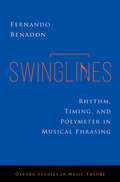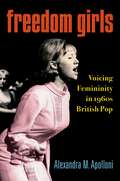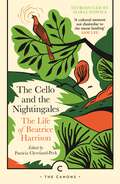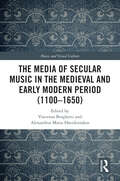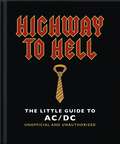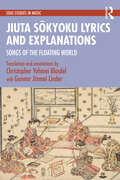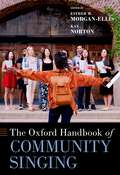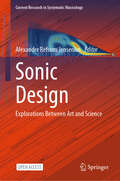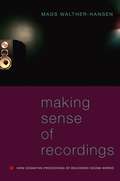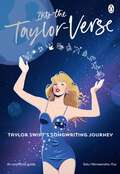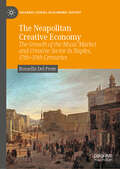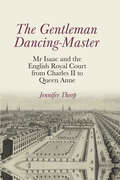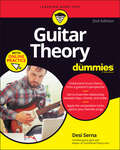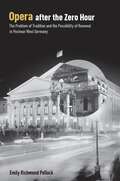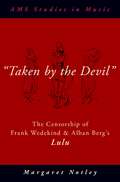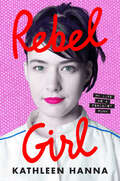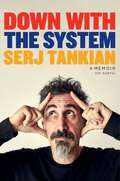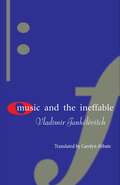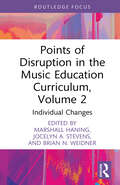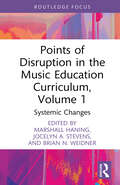- Table View
- List View
Swinglines: Rhythm, Timing, and Polymeter in Musical Phrasing (OXFORD STUDIES IN MUSIC THEORY)
by Fernando BenadonThe way rhythm is taught in Western classrooms and music lessons is rooted in a centuries-old European approach that favors metric levels within a grand symmetrical grid. Swinglines encourages readers to experience rhythms, even gridded ones, as freewheeling affairs irrespective of the metric hierarchy. At its core, this book is a nuts-and-bolts study of durational comparisons in the context of creative expression. It shows that rhythms traditionally framed as "deviations" and "non-isochronous" have their own identities. They are coherent products of precise musical thought and action. Rather than situating them in the neither-here-nor-there, author Fernando Benadon takes a more inclusive view, one where isochrony and metric grids are shown as particular cases within the universe of musical time. Rhythms that do not readily comply with the metered regime are often regarded as anomalies and deformations. The music explored in this book demonstrates how readily this paradigm vanishes once the frame is flipped from what rhythm is not to what rhythm is. As conceptualized here, swing flattens the temporal field to consider how note values relate to one another by any magnitude, not just the simple ratios of traditional theory. Musical analyses illustrate the book's concepts with the aid of transcriptions and timing-data visualizations. Variation, tuplets, polymeter, displacement, phrase structure, rhythmic counterpoint, parallel tempos, cyclical patterns, and time signatures are shown to be particular expressions that draw their contours from the swing continuum. They showcase the rich diversity of rhythm and propose ways to reframe how we think about musical time.
Watford Forever: How Graham Taylor and Elton John Saved a Football Club, a Town and Each Other
by John Preston Elton JohnThe Sunday Times Sports Book of the YearA Times Book of the YearA Financial Times Book of the YearA Guardian Book of the YearA New Statesman Book of the Year'The heartwarming story of the collaboration and friendship between English football’s oddest couple, Elton John and Graham Taylor' The Times' A wonderful, feel-good account of an ultimately English provincial story' Simon Kuper_____________________ An unforgettable British underdog story from one of our greatest narrative nonfiction writers, John Preston, and the international musical icon and bestselling author, Sir Elton John.Britain in the 1970s was beset by unrest and unemployment, as inflation soared, fuel was scarce, and hooliganism was on the rise. And for Watford FC, the outlook was even gloomier. Rundown and rat-infested, Watford were an ailing side with holes in their kit and barely enough fans to fill a stand. Of the 92 clubs in the Football League, spread across four divisions, Watford were in 92nd place.Meanwhile, Elton John was the most successful rockstar in the world. With six-inch platforms, spangled jumpsuits, and peroxide hair, he was glamorous, gay, and seemingly a world away from the semi-detached house in Pinner where he had supported Watford FC as a child. Many assumed he would move to America. Instead, he bought the football club.Watford Forever is the remarkable story of Elton John's ownership of Watford FC and its transformational journey to the top of the First Division under iconic manager Graham Taylor. Perhaps most remarkably, four of the same players who had been written off as has-beens went with them all the way from the bottom to the top. Inspiring and infectiously funny, this is a tribute to football's unlikeliest friendship as Elton John and Taylor, a straight-talking former fullback with a love of Vera Lynn, beat the odds and their personal demons to save a club and a community.Immersed in the grime and glamour of '70s Britain, Watford Forever is one of sport's great underdog stories and a love letter to the beautiful game.
Freedom Girls: Voicing Femininity in 1960s British Pop
by Alexandra M. ApolloniFreedom Girls: Voicing Femininity in 1960s British Pop shows how the vocal performances of girl singers in 1960s Britain defined-and sometimes defied-ideas about what it meant to be a young woman in the 1960s British pop music scene. The singing and expressive voices of Sandie Shaw, Cilla Black, Millie Small, Dusty Springfield, Lulu, Marianne Faithfull, and P.P. Arnold, reveal how vocal sound shapes access to social mobility, and consequently, access to power and musical authority. The book examines how Sandie Shaw and Cilla Black's ordinary girl personas were tied to whiteness and, in Black's case, her Liverpool origins. It shows how Dusty Springfield and Jamaican singer Millie Small engaged with the transatlantic sounds of soul and and ska, respectively, transforming ideas about musical genre, race, and gender. It reveals how attitudes about sexuality and youth in rock culture shaped the vocal performances of Lulu and Marianne Faithfull, and how P.P. Arnold has re-narrated rock history to center Black women's vocality. Freedom Girls draws on a broad array of archival sources, including music magazines, fashion and entertainment magazines produced for young women, biographies and interviews, audience research reports, and others to inform analysis of musical recordings (including such songs as "As Tears Go By," "Son of a Preacher Man," and others) and performances on television programs such as Ready Steady Go!, Shindig, and other 1960s music shows. These performances reveal the historical and contemporary connections between voice, social mobility, and musical authority, and demonstrate how singers used voice to navigate the boundaries of race, class, and gender.
The Cello and the Nightingales: The Life of Beatrice Harrison (Canons)
by Beatrice Harrison Patricia Cleveland-PeckIn 1924, Beatrice Harrison broadcast a miracle to the world: a wild nightingale singing with her cello. Over a million people tuned in to hear the nightingale that night, and the BBC went on to broadcast their duet worldwide every spring until 1942. This transformed the public interest in nightingales – a species already in decline. If Beatrice’s duets with the nightingales touched a chord with the world, her own life proved to be as musical, free-spirited and inspiring. From her early years as a musical prodigy to recording with the most important composers of the day or playing for the wounded in the Second World War, Beatrice’s warmth and love for sharing music are as endearing now as they were to her original audiences.
The Media of Secular Music in the Medieval and Early Modern Period (Music and Visual Culture)
by Vincenzo Borghetti and Alexandros Maria HatzikiriakosThis book brings a new perspective to secular music sources from the Middle Ages and early modernity by viewing them as media communication tools, whose particular features shape the meaning of their contents. Ranging from the eleventh to seventeenth centuries, and across countries and genres, the chapters offer innovative insights into the historical relationship between music and its presentation in a wide variety of media.The lens of media enables contributors to expand music history beyond notated music manuscripts and instruments to include images, furniture, luxury items, and other objects, and to address uniquely visual and material aspects of music sources in books and literature. Drawing together an international group of contributors, the volume pays close attention to the medial and material dimensions of musical sources, considering them as multifaceted objects that not only contain but also determine the nature of the music they transmit.Transforming our understanding of musical media, this volume will be of interest to scholars of musicology, art history, and medieval and early modern cultures.
The Media of Secular Music in the Medieval and Early Modern Period (Music and Visual Culture)
This book brings a new perspective to secular music sources from the Middle Ages and early modernity by viewing them as media communication tools, whose particular features shape the meaning of their contents. Ranging from the eleventh to seventeenth centuries, and across countries and genres, the chapters offer innovative insights into the historical relationship between music and its presentation in a wide variety of media.The lens of media enables contributors to expand music history beyond notated music manuscripts and instruments to include images, furniture, luxury items, and other objects, and to address uniquely visual and material aspects of music sources in books and literature. Drawing together an international group of contributors, the volume pays close attention to the medial and material dimensions of musical sources, considering them as multifaceted objects that not only contain but also determine the nature of the music they transmit.Transforming our understanding of musical media, this volume will be of interest to scholars of musicology, art history, and medieval and early modern cultures.
The Little Guide to AC/DC: For Those About to Read, We Salute You! (The\little Book Of... Ser.)
by Orange Hippo!Giving Satan Tinnitus Since 1973. Jacked up to the max with plenty of juice left to squeeze, AC/DC can still ignite their excitable audiences with their supercharged, power-cord hungry rock, even in 2023. This Little Guide to AC/DC is the ultimate, greatest hits compilation of the band's best bits in quick-fix shots, amped up to 11 with high voltage facts, shocking stats, killer quips and quotes, heavy-duty historic dates and thunderstruck trivia, a compact compendium of wit and wisdom that will keep every AC/DC fan as hard as a rock all night long. For those about to read, we salute you! 'I'm sick to death of people saying we've made 11 albums that sound exactly the same. In fact, we've made 12 albums that sound exactly the same.' Angus Young
Jiuta Sōkyoku Lyrics and Explanations: Songs of the Floating World (ISSN)
Jiuta Sōkyoku Lyrics and Explanations is a compendium of seventy-three representative songs from the well-known genre of traditional Japanese Edo-period sankyoku ensemble music.Including extensive annotations along with commentaries and notes on their musical and performative aspects, the collection begins with an overview which traces the history of the jiuta sōkyoku genre and the various socio-political influences at work in its formation. The translations and analyses are followed by a substantive glossary and bibliography, allowing for a deeper understanding of both the literary and musical aspects of jiuta sōkyoku compositions.Jiuta Sōkyoku Lyrics and Explanations is a comprehensive anthology that will be of great interest to researchers, including ethnomusicologists, Japanese studies scholars and poetry lovers who are fascinated with the literary and musical impact of the Edo period.
Jiuta Sōkyoku Lyrics and Explanations: Songs of the Floating World (ISSN)
by Christopher Yohmei Blasdel Gunnar Jinmei LinderJiuta Sōkyoku Lyrics and Explanations is a compendium of seventy-three representative songs from the well-known genre of traditional Japanese Edo-period sankyoku ensemble music.Including extensive annotations along with commentaries and notes on their musical and performative aspects, the collection begins with an overview which traces the history of the jiuta sōkyoku genre and the various socio-political influences at work in its formation. The translations and analyses are followed by a substantive glossary and bibliography, allowing for a deeper understanding of both the literary and musical aspects of jiuta sōkyoku compositions.Jiuta Sōkyoku Lyrics and Explanations is a comprehensive anthology that will be of great interest to researchers, including ethnomusicologists, Japanese studies scholars and poetry lovers who are fascinated with the literary and musical impact of the Edo period.
The Oxford Handbook of Community Singing (Oxford Handbooks)
The Oxford Handbook of Community Singing embraces an open-ended interpretation of socio-musical practices that can be described with the term community singing. The volume exemplifies community singing as an interdisciplinary field of study that encompasses diverse methodologies and objects of inquiry, and in the process brings together recent research from the fields that have historically engaged with the practice of group singing, including group dynamics, ethnomusicology, music history, music education, music therapy, community music, church music, music performance, sociology, political science, Latin American and North American studies, media studies, embodied psychology, theology, and philosophy. Chapters are divided into eight interdisciplinary sections: "Media and the Imagination of Community", "Singing in Place-Based Communities", "The Practitioner's Perspective", "Identity: Values, Ethnicity, and Inherited Culture", "Identity: Politics, Patriotism, and Assimilation", "Transgressing Borders, Seeking Asylum", "Singing and Political Action", and "New Paradigms". Each is prefaced with an introduction that traces the common threads running through the methodologically and topically diverse chapters that examine culturally specific narrow instances of community singing, each confined to a given time and place, in significant detail. The chapters explore community singing as one of two phenomena: the practice of singing as community--the utilization of collective song by communities of place or preference, and the singing of community into existence--the creation or identification of a new community, through singing, that did not exist before. Both practices can profoundly affect participants. The Handbook considers why communities are motivated to sing, what their activities mean, and how practitioners can improve the experience of singing together.
The Oxford Handbook of Community Singing (Oxford Handbooks)
by Esther M. Morgan-Ellis, Kay NortonThe Oxford Handbook of Community Singing embraces an open-ended interpretation of socio-musical practices that can be described with the term community singing. The volume exemplifies community singing as an interdisciplinary field of study that encompasses diverse methodologies and objects of inquiry, and in the process brings together recent research from the fields that have historically engaged with the practice of group singing, including group dynamics, ethnomusicology, music history, music education, music therapy, community music, church music, music performance, sociology, political science, Latin American and North American studies, media studies, embodied psychology, theology, and philosophy. Chapters are divided into eight interdisciplinary sections: "Media and the Imagination of Community", "Singing in Place-Based Communities", "The Practitioner's Perspective", "Identity: Values, Ethnicity, and Inherited Culture", "Identity: Politics, Patriotism, and Assimilation", "Transgressing Borders, Seeking Asylum", "Singing and Political Action", and "New Paradigms". Each is prefaced with an introduction that traces the common threads running through the methodologically and topically diverse chapters that examine culturally specific narrow instances of community singing, each confined to a given time and place, in significant detail. The chapters explore community singing as one of two phenomena: the practice of singing as community--the utilization of collective song by communities of place or preference, and the singing of community into existence--the creation or identification of a new community, through singing, that did not exist before. Both practices can profoundly affect participants. The Handbook considers why communities are motivated to sing, what their activities mean, and how practitioners can improve the experience of singing together.
Sonic Design: Explorations Between Art and Science (Current Research in Systematic Musicology #12)
by Alexander Refsum JenseniusThis open access book offers a historical context and an overview of the field's current artistic and scientific research. Sonic design includes the construction and performance of acoustic instruments but also recording, editing, mixing, and synthesizing sounds using analog and digital electronic devices. This book explores sonic design from the perspectives of music theory, music perception, embodied cognition, phenomenology, soundscape studies, acoustics, new interfaces for musical expression, sound and music computing, and music information retrieval. The chapters are selected contributions from an international seminar organized to celebrate the achievements of Professor Rolf Inge Godøy at the University of Oslo. As a composer, researcher, teacher, and supervisor, Professor Godøy has been central in developing a holistic approach to sonic design, from theory to practice. This book offers a comprehensive overview of the field's current state, making it essential reading for students, practitioners, and researchers across a wide range of disciplines.
Making Sense of Recordings: How Cognitive Processing of Recorded Sound Works
by Mads Walther-HansenBuilding on ideas from cognitive metaphor theory, Making Sense of Recordings offers a new perspective on record production, music perception, and the aesthetics of recorded sound. It shows how the language about sound is intimately connected to sense-making - both as a reflection of our internal cognitive capacities and as a component of our extended cognitive system. In doing so, the book provides the foundation for a broader understanding of the history of listening, discourses of sound quality, and artistic practices in the age of recorded music. The book will be of interest to anyone who asks how recorded music sounds and why it sounds as it does, and it will be a valuable resource for musicology students and researchers interested in the analysis of sound and the history of listening and record production. Additionally, sound engineers and laptop musicians will benefit from the book's exploration of the connection between embodied experiences and our cognitively processed experiences of recorded sound. The tools provided will be useful to these and other musicians who wish to intuitively interact with recorded or synthesized sound in a manner that more closely resembles the way they think and that makes sense of what they do.
Into the Taylor-Verse: A tour of Taylor Swift's songwriting journey through the eras
by Satu Hämeenaho-FoxFearlessly jump and fall into the world of Taylor Swift with this illustrated appreciation of her music by Swiftian Theory co-founder Satu Hämeenaho-Fox.This is the book for all Swifties of every era, and the perfect gift for the Taylor Swift fan in your life.Get ready to deep dive into the story of Taylor’s life through her songwriting. Travel back to where it all began with her debut album Taylor Swift and journey through the eras, from the enchanting moments of Speak Now and 1989's red-heart sunglasses, to the cosy cardigan's of Folklore and bejewelled Midnights.Including the musical influences and personal experiences that helped make Taylor the mastermind and icon she is, this book celebrates the inimitable talent of one of the world’s greatest songwriters, performers and cat lovers.Covering her groundbreaking tours, fiercely loyal fans and inspiring position as a businesswoman, discover how Taylor uses her signature themes of girlhood, heartbreak and female friendship to master her craft, and how her genius for poignant lyrics and planting secret clues has developed her music into a whole universe for Swifties to explore.Are you ready for it?
The Neapolitan Creative Economy: The Growth of the Music Market and Creative Sector in Naples, 17th–19th Centuries (Palgrave Studies in Economic History)
by Rossella Del PreteThis book analyses the emergence and growth of the creative sector in Naples between the early modern and modern eras, focusing particularly on the development of music markets in the city. From the seventeenth century, Naples became one of the most culturally enriched regions in the Italian peninsula, with internationally known music schools, theatres and opera venues attracting visitors from across Europe in a burgeoning tourist market. This book sheds light on the driving economic factors and political contexts behind this key case study for the early growth of the opera and music sector in Europe. Starting with a discussion of the value of economic history to understanding cultural industries, the chapters approach this analysis through multiple lenses: the formation of human capital as the result of Naples’ institutional urban welfare system; the role of cultural consumption as it evolved from a primarily religious activity to growing popular demand; and the rolethat central city authorities played in encouraging cultural activity through private investment and public policy. The book also draws on fascinating archival research to examine the contribution of Naples’ music conservatories in the local creative economy. This book is a valuable resource to a broad range of readers, including those working in economic history, tourism history, the history of music and theatre, Italian social history and more.
The Gentleman Dancing-Master: Mr Isaac and the English Royal Court from Charles II to Queen Anne (Clemson University Press: Studies in British Musical Cultures)
by Jennifer ThorpThe Gentleman Dancing-Master: Mr Isaac and the English Royal Court from Charles II to Queen Anne is a study of the life of the most significant dancing-master at the late-Stuart court in London. It discusses his use of dance music and brings together, for the first time, reprints of the notations of all his twenty-three surviving dances created for performance at court in the presence of the monarch, including several created to celebrate the birthdays of Queen Anne or named after important courtiers or political events. This study highlights the significance of dance as a central part of court culture, and also the wider context of the London book trade within which Isaac’s notators turned his dances into a publishable form ultimately taken over by John Walsh’s music publishing firm. Using extensive archival and printed sources from his day, the book follows Isaac’s career as a dancer, teacher, and choreographer of sophisticated duets in the fashionable French style, some of which were also performed in the theatre. Isaac, however, was no slavish follower of French fashion, and by careful consideration of the extant dances from the point of view of a dancer, this study also seeks to throw light on Isaac’s often individualistic approach to choreography.
Guitar Theory For Dummies with Online Practice: Book + Online Video And Audio Instruction
by Desi SernaMake your guitar sing with insight on music theory brings your instrument to life There’s a universe of incredible music living in your guitar. You just need to discover how to let it out. In Guitar Theory For Dummies, expert guitarist and instructor Desi Serna walks you through the music theory concepts you need to understand to expand your musical horizons. From deciphering the mysteries of the fretboard to adapting chord progressions to a song’s key, you’ll master techniques that will help you move past simple, three-chord songs to more complex and creative pieces. Build on your existing knowledge of open and barre chords and simple progressions with practical instruction that demystifies scales and chord voicings and shows you how to bring them together to create impressive music. You can also jump over to dummies.com to hear audio samples of the examples featured in the book. You’ll also learn: How chords, keys, and scales are built and how they interact with one another Powerful concepts, like intervals, chord extensions, modes and modal scales, that grant access to a world of musical possibilities How popular songs apply elements of guitar theory and how you can apply the same techniques Free yourself from the confines of tab sheets and simple chords and start enjoying all the musical potential of your guitar. Guitar Theory For Dummies is for anyone who wants to unlock the next stage of their musical journey.
Opera After the Zero Hour: The Problem of Tradition and the Possibility of Renewal in Postwar West Germany
by Emily Richmond PollockOpera After the Zero Hour: The Problem of Tradition and the Possibility of Renewal in Postwar West Germany presents opera as a site for the renegotiation of tradition in a politically fraught era of rebuilding. Though the "Zero Hour" put a rhetorical caesura between National Socialism and postwar West Germany, the postwar era was characterized by significant cultural continuity with the past. With nearly all of the major opera houses destroyed and a complex relationship to the competing ethics of modernism and restoration, opera was a richly contested art form, and the genre's reputed conservatism was remarkably multi-faceted. Author Emily Richmond Pollock explores how composers developed different strategies to make new opera "new" while still deferring to historical conventions, all of which carried cultural resonances of their own. Diverse approaches to operatic tradition are exemplified through five case studies in works by Boris Blacher, Hans Werner Henze, Carl Orff, Bernd Alois Zimmermann, and Werner Egk. Each opera alludes to a distinct cultural or musical past, from Greek tragedy to Dada, bel canto to Berg. Pollock's discussions of these pieces draw on source studies, close readings, unpublished correspondence, institutional history, and critical commentary to illuminate the politicized artistic environment that influenced these operas' creation and reception. The result is new insight into how the particular opposition between a conservative genre and the idea of the "Zero Hour" motivated the development of opera's social, aesthetic, and political value after World War II.
"Taken by the Devil": The Censorship of Frank Wedekind and Alban Berg's Lulu (AMS Studies in Music)
by Margaret NotleyCensorship had an extraordinary impact on Alban Berg's opera Lulu, composed by the Austrian during the politically tumultuous years spanning 1929 to 1935. Based on plays by Frank Wedekind that were repeatedly banned from being published and performed from 1894 until the end of World War I, the libretto was in turn censored by Berg himself when he characterized it as a morality play after submitting it to authorities in Nazi Germany in 1934. After Berg died the next year, the third act was censored by his widow, Helene, and his former teacher, Arnold Schoenberg. In "Taken by the Devil", author Margaret Notley uncovers the unusual and uniquely generative role of censorship throughout the lifecycle of Berg's great opera. Placing the opera and its source material in wider cultural contexts, Notley provides close readings of the opera's libretto and score to reveal techniques employed by the composer and by Wedekind before him in negotiating censorship. She also explores ways in which Berg chose to augment discrepancies between the plays rather than flatten them as in certain performances of the plays during the 1920s, adding further dimensions of interpretation to the work. Elegantly readable, "Taken by the Devil" is one of the most meticulously researched and nuanced studies of Lulu to date, and illuminates the process of politically-driven censorship of theater, music, and the arts during the tumultuous early twentieth century.
Rebel Girl: My Life as a Feminist Punk
by null Kathleen HannaAn electric, searing memoir by the original rebel girl and legendary frontwoman of Bikini Kill and Le Tigre Kathleen Hanna’s rallying cry to feminists echoed far and wide through the punk scene of the 1980s, ’90s, and beyond. Her band, Bikini Kill, embodies this iconic time, and today their gutsy, radical lyrics of anthems like ‘Rebel Girl’ and ‘Double Dare Ya’ are more powerful than ever. But where did this transformative voice come from? In Rebel Girl, Hanna’s raw and insightful new memoir, she takes us from her tumultuous childhood home, to her formative college years in Olympia, Washington, and on to her first years on tour, fighting hard for gigs and for her band. As Hanna makes blindingly clear, being in a ‘girl band’, especially a punk girl band, in those years was not a simple or a safe prospect. Male violence and antagonism threatened at every turn, and surviving as a band took limitless amounts of grit and bravery. But the relationships she developed during those years buoyed her – including with her bandmates Tobi Vail, Kathi Wilcox, and Billy Karren; her friendship with Kurt Cobain; and her introduction to Joan Jett – and they were a testament to how the true punk world nurtured and cared for its own. Hanna opens up about falling in love with Ad-Rock of the Beastie Boys and her debilitating battle with Lyme disease, and she brings us behind the scenes of her later bands, Le Tigre and The Julie Ruin. She also writes candidly about the Riot Grrrl movement and its decline, documenting with love its grassroots origins but critiquing its later exclusivity. In an uncut voice all her own, Hanna reveals the darkest, hardest times along with the most joyful – and how it all fuelled her revolutionary art, from the 1980s to today.
Down with the System: The highly-awaited memoir from the System Of A Down legend
by Serj TankianThe incredible first memoir by System Of A Down frontman Serj TankianWith nearly 40 million record sales, three albums topping the Billboard charts, a Grammy win and a legion of fans, System Of A Down are one of the biggest metal bands on the planet. At their core has always been Serj Tankian, whose journey from the streets of Beirut to rock superstardom is as remarkable and unlikely as you'll get. By dint of luck, circumstance, struggle, and more than a little talent, Serj has had the chance to live an extraordinary life. In Down With the System, he retraces this remarkable and unlikely journey, and explores what it's taught him - about music, about art, about activism, and about himself. From teaming up with Tom Morello to push social justice causes on unsuspecting metalheads, arguing with LAPD officers over the best way to quell his rioting fans, and traveling with Anthony Bourdain through Armenia one meal at a time, Down With the System is an immigrant's tale, an activist's awakening, and rock memoir unlike any other.
Music and the Ineffable
by Vladimir JankélévitchThe classic work on the philosophy of music—now available in English to a new generation of readersVladimir Jankélévitch left behind a remarkable body of work steeped as much in philosophy as in music. His writings on moral quandaries reflect a lifelong devotion to music and performance, and, as a counterpoint, he wrote on music aesthetics and on modernist composers such as Fauré, Debussy, and Ravel. Music and the Ineffable brings together these two threads, the philosophical and the musical, as an extraordinary quintessence of his thought. Jankélévitch deals with classical issues in the philosophy of music, including metaphysics and ontology. These are a point of departure for a sustained examination and dismantling of the idea of musical hermeneutics in its conventional sense.Music, Jankélévitch argues, is not a hieroglyph, not a language or sign system; nor does it express emotions, depict landscapes or cultures, or narrate. On the other hand, music cannot be imprisoned within the icy, morbid notion of pure structure or autonomous discourse. Yet if musical works are not a cipher awaiting the decoder, music is nonetheless entwined with human experience, and with the physical, material reality of music in performance. Music is "ineffable," as Jankélévitch puts it, because it cannot be pinned down, and has a capacity to engender limitless resonance in several domains. Jankélévitch's singular work on music was central to such figures as Roland Barthes and Catherine Clément, and the complex textures and rhythms of his lyrical prose sound a unique note, until recently seldom heard outside the francophone world.
Music and the Ineffable
by Vladimir JankélévitchThe classic work on the philosophy of music—now available in English to a new generation of readersVladimir Jankélévitch left behind a remarkable body of work steeped as much in philosophy as in music. His writings on moral quandaries reflect a lifelong devotion to music and performance, and, as a counterpoint, he wrote on music aesthetics and on modernist composers such as Fauré, Debussy, and Ravel. Music and the Ineffable brings together these two threads, the philosophical and the musical, as an extraordinary quintessence of his thought. Jankélévitch deals with classical issues in the philosophy of music, including metaphysics and ontology. These are a point of departure for a sustained examination and dismantling of the idea of musical hermeneutics in its conventional sense.Music, Jankélévitch argues, is not a hieroglyph, not a language or sign system; nor does it express emotions, depict landscapes or cultures, or narrate. On the other hand, music cannot be imprisoned within the icy, morbid notion of pure structure or autonomous discourse. Yet if musical works are not a cipher awaiting the decoder, music is nonetheless entwined with human experience, and with the physical, material reality of music in performance. Music is "ineffable," as Jankélévitch puts it, because it cannot be pinned down, and has a capacity to engender limitless resonance in several domains. Jankélévitch's singular work on music was central to such figures as Roland Barthes and Catherine Clément, and the complex textures and rhythms of his lyrical prose sound a unique note, until recently seldom heard outside the francophone world.
Points of Disruption in the Music Education Curriculum, Volume 2: Individual Changes (CMS Pedagogies and Innovations)
by Marshall Haning Jocelyn A. Stevens Brian N. WeidnerFor decades, scholars in the field of music education have recognized the need for growth and change in our approach to teaching music, yet despite these calls for change, the music education curriculum today remains remarkably similar to that of a century ago. Points of Disruption in the Music Education Curriculum, Volume 2: Individual Changes is one of two volumes that bring together applied suggestions, analyses, and best practices for disrupting cycles of replication in the curriculum of K-12 and collegiate music education programs in the United States and beyond, considering disruption as a force for positive change. Identifying specific strategies for interrupting or reimagining traditional practices, the contributors provide music teachers and music educators with a variety of potential practical approaches to creating changes that foster a better musical education at all levels of the curriculum.This second volume focuses on changes that can be implemented by individual educators, covering topics including transcultural approaches, student-teacher power relations, methods courses, integrated music education, and administrator support of teacher agency, student–teacher power relations, and reimagining music education. Bringing together 6 thought-provoking chapters, this book offers a diverse set of concrete strategies that will be useful to a wide range of music education stakeholders, including teachers, administrators, and curriculum designers.
Points of Disruption in the Music Education Curriculum, Volume 1: Systemic Changes (CMS Pedagogies and Innovations)
by Marshall Haning Jocelyn A. Stevens Brian N. WeidnerFor decades, scholars in the field of music education have recognized the need for growth and change in our approach to teaching music, yet despite these calls for change, the music education curriculum today remains remarkably similar to that of a century ago. Points of Disruption in the Music Education Curriculum, Volume 1: Systemic Changes is one of two volumes that bring together applied suggestions, analyses, and best practices for disrupting cycles of replication in the curriculum of K-12 and collegiate music education programs in the United States and beyond, considering disruption as a force for positive change. Identifying specific strategies for interrupting or reimagining traditional practices, the contributors provide music teachers and music educators with a variety of potential practical approaches to creating changes that foster a better musical education at all levels of the curriculum.This first volume focuses on systemic changes, including topics like professional development, hiring practices, ableism and universal design, rhizomatic learning, and how to implement disruption across the music education profession. Each chapter contains specific action steps and suggestions for implementation. Bringing together five thought-provoking chapters, this concise volume offers a diverse set of concrete strategies that will be useful to a wide range of music education stakeholders, including teachers, administrators, and curriculum designers.
